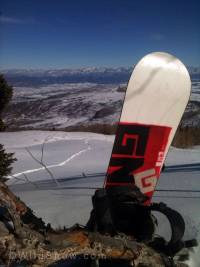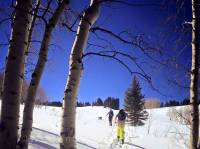Aaron Mattix

Given the WildSnow penchant for charts, graphs, and data collection, perhaps an equation could be derived to track the ratio of money spent up front on gear/fitment/training v. ease of transitioning into backcountry? Click all images to enlarge.
So you’ve decided on exploring backcountry skiing, but are leery of laying down your hard-earned coin for a bunch of gear you barely understand. Given a sufficient fund of enthusiasm and resourcefulness, you can collect the gear, and experience you need, while minimizing collateral damage to your finances.
First, and foremost, it should be recognized that you are trading off convenience for cash. Understand that you will be offsetting financial cost with sweaty armpits, burning legs, chest-deep flailing, fumbled buckles, cold snow in places that should be warm and dry, and immense heapings of humility.
This strategy only works if exploring the backcountry is an itch you can’t scratch, the question that won’t go away, the koan you can’t put down. IT IS NOT: a strategy for getting your significant other into the sport, who has said, “Oh, I don’t know. Maybe I would give it a try sometime…”
What I offer is my experience, not expert advice. I came to the world of ski touring in my early 30’s, my only prior experience with snow being a report I wrote on snowboarding in seventh grade. To spell it out boldly, there is as many (most likely more) mistakes as excellence in my method.
First spend time at a resort, and polish your skill level up to at least low-level intermediate. Be able to reliably make it down groomed runs in full control, then start exploring the powder and open trees at the resort before your first foray out of bounds.
Snowboarding was my point of entry, as the gear can be had much cheaper, and is not quite as specific (virtually all snowboard boots already have a “walk” mode, by virtue of their softer construction).
For less than $100, I was able to posthole my way to the top of the nearest untracked slope. My method of navigation was to grab an aspen tree and pivot, recover from crash, aim for next aspen tree, repeat. It took me roughly as long to get down as it did to get to the top, so I figured one lap was good enough to call things even.
As a ski touring beginner, I had no idea of the inefficiencies I was enduring. It was simply the means within my grasp to get to the top of the hill. More than any blog post or spreadsheet, the existence of a better way was most clearly illustrated the first time I went back to the same spot with a friend on a splitboard setup, who cruised along top the snow, while I punched thigh deep holes.
A splitboard would have been the cheapest next step, but knowing my proclivities for bushwhacking, and general exploring, skis were the logical endpoint. I had crossed the threshold from vague interest in playing on snow to committed pursuit of backcountry exploration. With this series of investments, the expenditure curve rose sharply, while the frustration curve flattened significantly, and access to terrain opened exponentially.
Though each of these expenditures was nearly as much as I spent on my second hand snowboard set up, they were easily staged out. Purists of thrift may note that items such as poles are often to be found in surplus. Relying on hand-me-down gear has the tattered glory of dirtbag tradition attached to it, but there is dignity and gumption-building in collecting your own set of dedicated gear.
For the beginner’s tabula rosa, each piece of gear is an introduction to its basic function, and the starting point from which you can say, “I wish it would do this better…”
I started with frame bindings (Atomic Tracker 13), because it was the cheapest entry point I could find into touring bindings, not for cliff-hucking beef. The weight factor really didn’t even enter my mind until my first hut trip. On the seven mile skin in from Hunter Creek trailhead to the Fritz Benedict hut, I finally realized that whatever “fast & light” gear was, it was not what I was dragging on my feet. This season, I have upgraded to Dynafit Speed Radical bindings, and TLT 6 boots; awaiting new skis to complete my own “fast and light” set up. The WildSnow preference for tech bindings may come across as elitism, but the more time spent earning turns, the more apparent the lightweight advantages of the tech binding become.
My experience illustrates the vector of the cost:benefit ratio. The willingness to exchange capital for efficiency of movement rises sharply the more committed one becomes to exploring the sport. As a beginner, one is able to enjoy tremendous leaps in proficiency, even on low-level equipment. Would the learning curve be easier on better equipment? Certainly.
If the goal is to become proficient at ski touring as soon as possible, start with the best gear you can afford. However, this approach denies the beginner the chance to experience the full spectrum of improvement in gear. By starting on low-budget, less-refined gear, one grasps a sense of the history of technical progression, and the reasoning behind gear evolution.
(Guest blogger Aaron Mattix grew up in Kansas and wrote a report on snowboarding in seventh grade. His first time to attempt snowboarding was in 2012, and soon switched over to skis for backcountry exploration near his home in Rifle, CO. His skill level is “occasionally makes complete runs without falling.” In the summer, he owns and operates Gumption Trail Works, building mountain bike singletrack and the occasional sweet jump.)
Beyond our regular guest bloggers who have their own profiles, some of our one-timers end up being categorized under this generic profile. Once they do a few posts, we build a category. In any case, we sure appreciate ALL the WildSnow guest bloggers!


